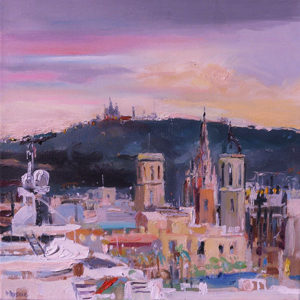POLÒNIA, 1971 Piotr Perski

The lived experiences of Piotr Perski link urban landscapes and rural corners through the line drawn by the artist.
Piotr Perski transforms a real character, a daily landscape, into a recreated place where the viewer finds new senses, hidden emotions that appear revealed through the artist’s gaze.
LOOKS
by Josep M. Barragán Rodríguez. Doctor and Professor of the Faculty of Fine Arts. University of Barcelona
Artists, often with difficulties to coexist with the social conditions imposed by the world in which we live, have but a great privilege, can create worlds, can give form, matter and consistency to ideas, experiences and emotions that become part of of the universe parallel to the real one. It also offers the viewer the opportunity to live different experiences than those he has in his daily life or even change his look towards this reality.
Piotr Perski, is an example of this artistic attitude that transforms a real character, a daily landscape, into a recreated place where the viewer finds new senses, hidden emotions that appear revealed through the artist’s gaze.
He came from Poland in Spain with the scholarship from the Ministry of Foreign Affairs and is finishing his doctoral thesis at the UB de Barcelona. During his stay in Barcelona, he has made numerous exhibitions in Spain, Poland, Germany, Cyprus, Singapore and several in the USA.
The paintings of Barcelona, a city where the Polish artist has been established for more than 16 years, offer us new perspectives, a new experience modestly, generously shared: the strength of life in the environment and the time it needs, perhaps already forgotten, the times we dedicate to live without seeing, without looking. And a deep knowledge of the representation of the city and the choice of the procedures of the pictorial medium.
In his works we will see: buildings, skies and general views of cities and nature, some well known, but distilled by his choice. It is not easy to reinterpret the more or less topical images of these views, beaches, ports and show a personal vision. Piotr Perski does it: the commitment to the representation of nature, an attitude of the nineteenth century, which over the years is again innovative, because it makes us think about the process of representation (this is the case in the artistic field) and the option for the reduction of resources among all that painting has offered for thousands of years, are its devices of artistic discourse.
The result is paintings that are now again surprising if you stop to look a little, exciting, because they convey the lived experience of the moment. If the spectator enters into the game of the gaze that his works propose to us, he will look again and will be able to participate in the silent, sincere, passionate struggle of a painter who saves the fleeting perceptions of these places and retains them, without freezing them (as occurs in photography) to his painting. It is not the images of Barcelona and other places thousand times represented, thousand times photographed, they are the lived experiences of Piotr Perski that link urban landscapes and rural corners through the line that the artist draws. The resources: the formats, the choice of the point of view and the horizon line, the chromatic ranges, the brush strokes (yes, the trace left by the brush) and the pictorial representation of light. In the Looks with Piotr Perski, we rediscover the city through the formats: landscape cuts within the limit of the possible, some elongated to the extreme, others also extremely vertical, or square but in an inordinate proportion, and light elusive, that goes drawing the forms, between lights and shadows, and translated in dense spots of color (with thousands of nuances) that dominate the general views.
The concentration of buildings. Sometimes the buildings occupy a large part of the painting and the artist recreates himself in the piled up vision, with characteristic signs of his urban organization through the streets: sometimes straight, sometimes labyrinthine, sometimes in sharp perspectives in his descent towards the sea, sometimes climbing towards the hills. Sometimes barely recognizable and traced with an invisible drawing under the pictorial layer with a chromatic reduction that, in appearance, only points to white, gray, blue, green and sienna, but laden with nuances that maintain the form.
Immeasurable skies and cloud formations, some believe impossible, but they exist … can be rediscovered, following the look. The proportion and formal disproportion. And always with a surprising disproportion of flashes of the chromatic range that go from yellow to violent red, passing through all the golden, orange pink … are the fleeting colors of the sunset of the day.
The sea and the sky, in strips of masses of sometimes heavy colors like lead, the color with which they have been painted, with turquoise, cobalt, indigo and white vibrations, dazzling.
The fog, this atmospheric phenomenon so relevant and inevitable in the landscape of Barcelona and other places open to the sea, is uncomfortable for the representation, but in his experience and restless gaze, Piotr can not ignore it. Not without ignoring the port of Barcelona, not without ignoring the Bay of Menorca, it seems impossible to paint that diffuse mass of tiny particles that sometimes envelops the landscape, but Piotr Perski does.
The artistic work of Piotr Perski is a possibility, it is a good excuse in this case, to save us from the boredom of everyday perceptions.

